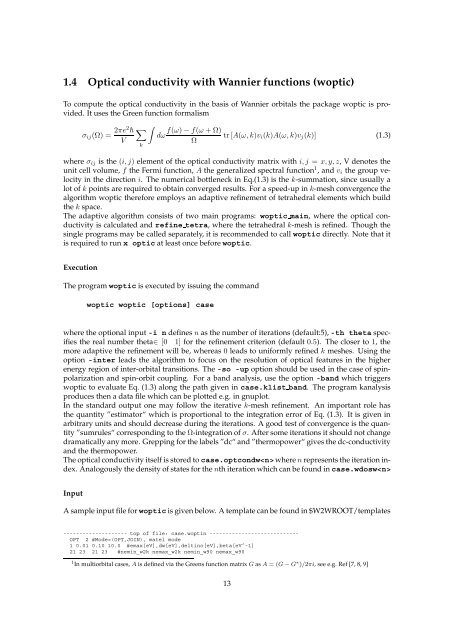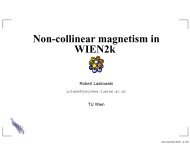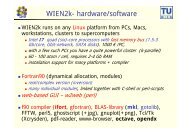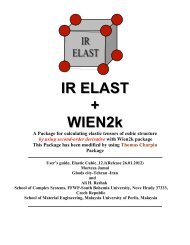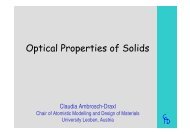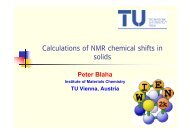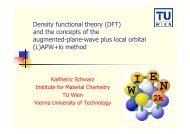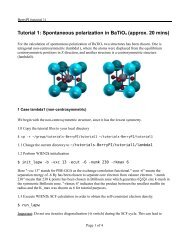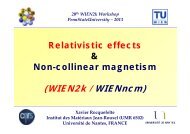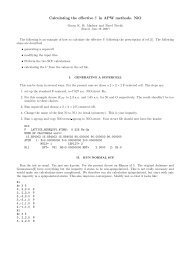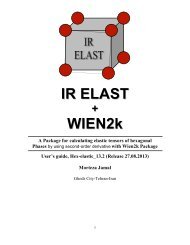userguide WIEN2WANNIER: From linearized augmented ... - WIEN 2k
userguide WIEN2WANNIER: From linearized augmented ... - WIEN 2k
userguide WIEN2WANNIER: From linearized augmented ... - WIEN 2k
Create successful ePaper yourself
Turn your PDF publications into a flip-book with our unique Google optimized e-Paper software.
1.4 Optical conductivity with Wannier functions (woptic)To compute the optical conductivity in the basis of Wannier orbitals the package woptic is provided.It uses the Green function formalismσ ij (Ω) = 2πe2 V∑∫kf(ω)−f(ω +Ω)dω tr[A(ω,k)v i (k)A(ω,k)v j (k)] (1.3)Ωwhere σ ij is the (i,j) element of the optical conductivity matrix with i,j = x,y,z, V denotes theunit cell volume, f the Fermi function, A the generalized spectral function 1 , and v i the group velocityin the direction i. The numerical bottleneck in Eq.(1.3) is the k-summation, since usually alot of k points are required to obtain converged results. For a speed-up ink-mesh convergence thealgorithm woptic therefore employs an adaptive refinement of tetrahedral elements which buildthe k space.The adaptive algorithm consists of two main programs: woptic main, where the optical conductivityis calculated and refine tetra, where the tetrahedral k-mesh is refined. Though thesingle programs may be called separately, it is recommended to call woptic directly. Note that itis required to run x optic at least once before woptic.ExecutionThe program woptic is executed by issuing the commandwoptic woptic [options] casewhere the optional input -i n defines n as the number of iterations (default:5), -th theta specifiesthe real number theta∈ [0 1] for the refinement criterion (default 0.5). The closer to 1, themore adaptive the refinement will be, whereas 0 leads to uniformly refined k meshes. Using theoption -inter leads the algorithm to focus on the resolution of optical features in the higherenergy region of inter-orbital transitions. The -so -up option should be used in the case of spinpolarizationand spin-orbit coupling. For a band analysis, use the option -band which triggerswoptic to evaluate Eq. (1.3) along the path given in case.klist band. The program kanalysisproduces then a data file which can be plotted e.g. in gnuplot.In the standard output one may follow the iterative k-mesh refinement. An important role hasthe quantity ”estimator“ which is proportional to the integration error of Eq. (1.3). It is given inarbitrary units and should decrease during the iterations. A good test of convergence is the quantity”sumrules“ corresponding to theΩ-integration ofσ. After some iterations it should not changedramatically any more. Grepping for the labels ”dc“ and ”thermopower“ gives the dc-conductivityand the thermopower.The optical conductivity itself is stored to case.optcondw wherenrepresents the iteration index.Analogously the density of states for thenth iteration which can be found in case.wdoswInputA sample input file for woptic is given below. A template can be found in $W2WROOT/templates-------------------- top of file: case.woptin ----------------------------OPT 2 #Mode=(OPT,JOIN), matel mode1 0.01 0.10 10.0 #emax[eV],dw[eV],deltino[eV],beta[eVˆ-1]21 23 21 23 #nemin_w<strong>2k</strong> nemax_w<strong>2k</strong> nemin_w90 nemax_w901 In multiorbital cases, A is defined via the Greens function matrix G as A = (G−G ∗ )/2πi, see e.g. Ref [7, 8, 9]13


